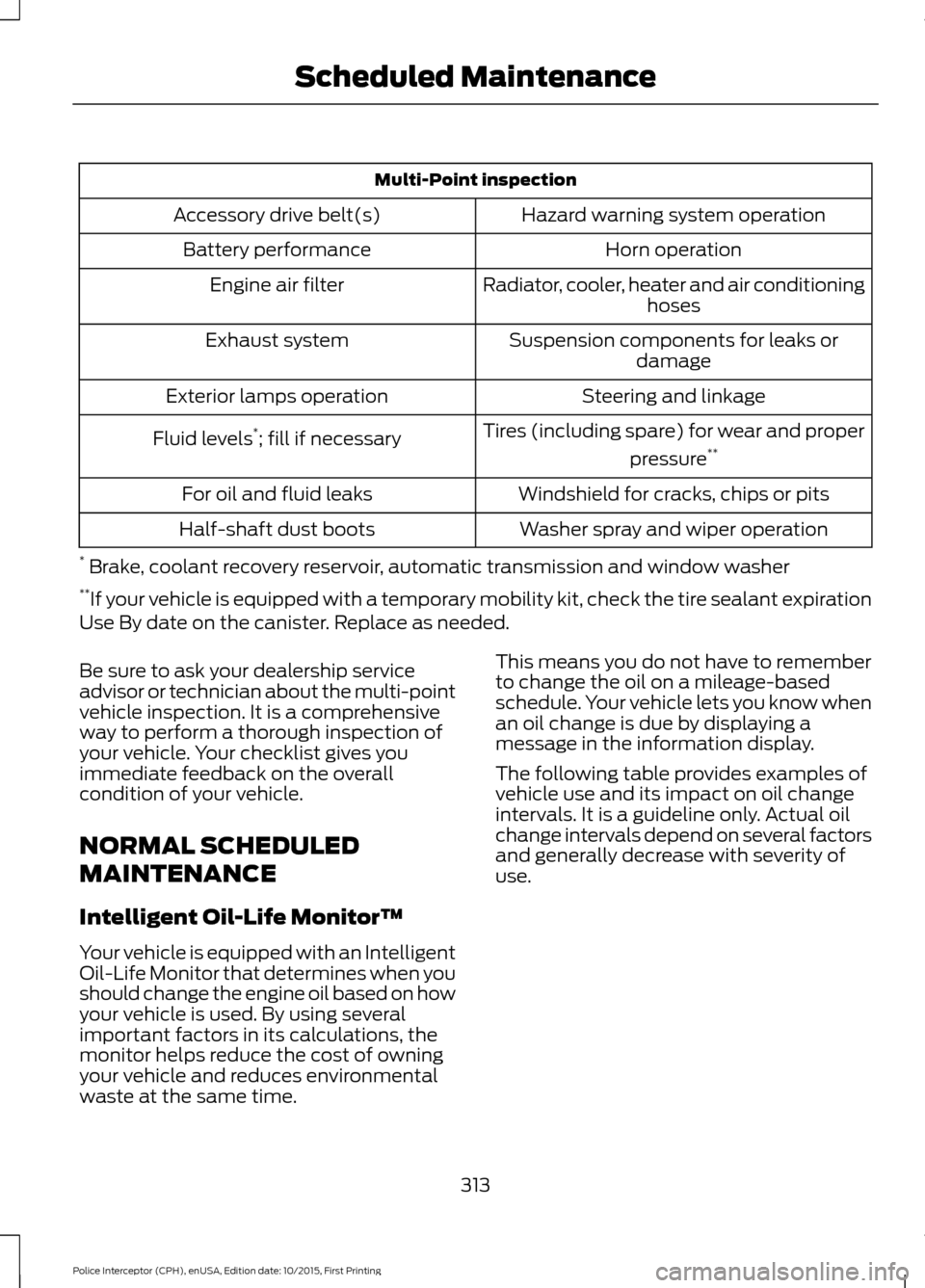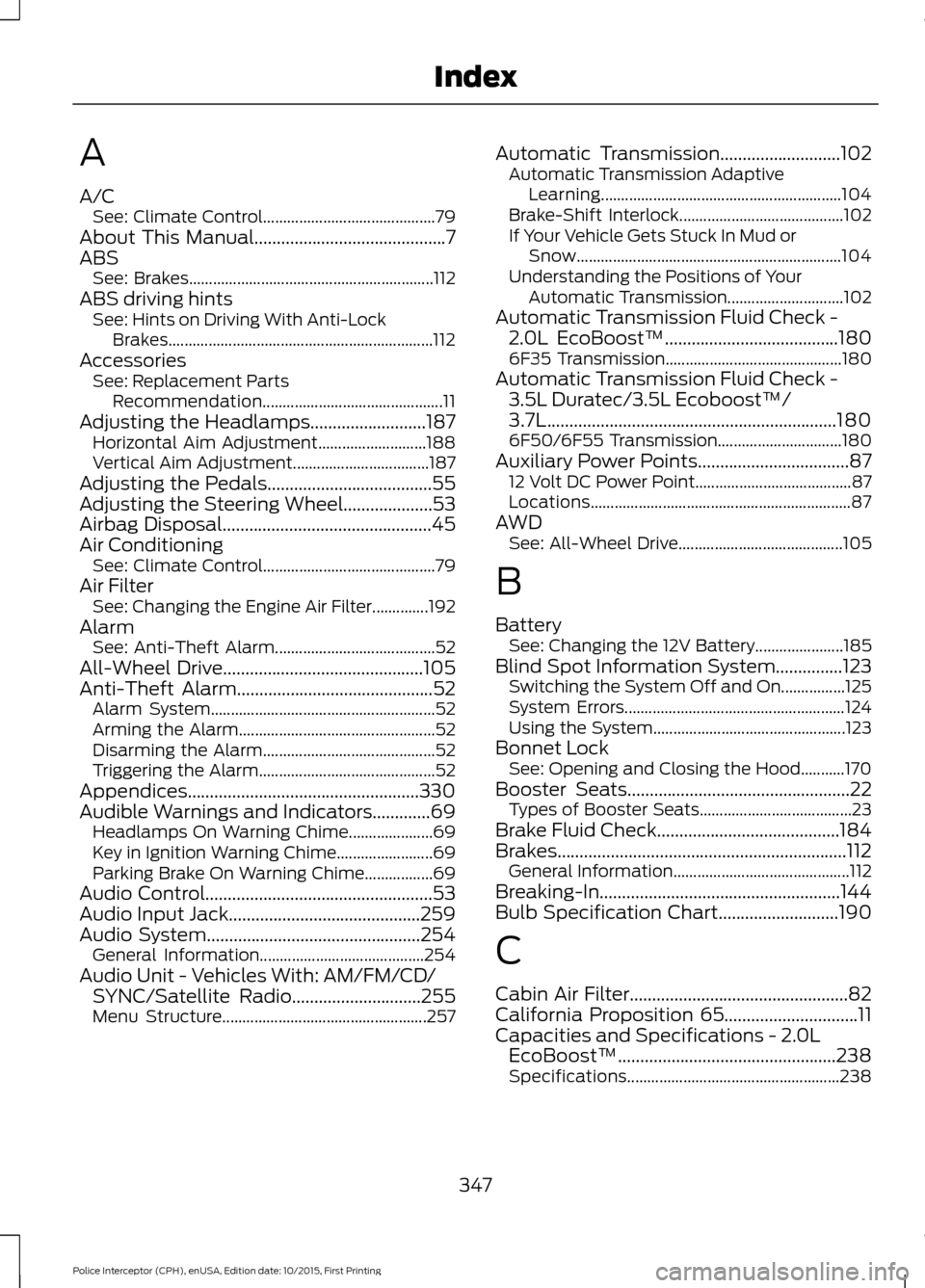2016 FORD POLICE INTERCEPTOR SEDAN check transmission fluid
[x] Cancel search: check transmission fluidPage 186 of 358

Check the transmission fluid at the normal
operating temperatures between 180°F
(82°C) and 200°F (93°C) on a level
surface. Drive your vehicle until you warm
it up to the normal operating temperature
after approximately 20 mi (30 km).
Target the transmission fluid level within
the cross-hatch area if at the normal
operating temperature between 180°F
(82°C) and 200°F (93°C).
High fluid level If the fluid level is above the MAX range of
the dipstick, remove fluid to reach the
hashmark level.
Note:
Fluid level above the MAX level may
cause shift or engagement concerns or
possible damage. An overheating condition
can cause high fluid levels. If you operate
your vehicle for an extended period at high
speeds, in city traffic during hot weather or
pulling a trailer, you should switch your
vehicle off until your vehicle reaches normal
operating temperatures. Depending on
vehicle use, cooling times could take up to
30 minutes or longer. Adjusting Automatic Transmission Fluid
Levels
Before adding any fluid, make sure the
correct type is used. The type of fluid used
is normally indicated on the dipstick and
in the Technical Specifications section in
this chapter.
Note:
An overfill condition of transmission
fluid may cause shift or engagement
concerns or possible damage.
Do not use supplemental transmission
fluid additives, treatments or cleaning
agents. The use of these materials may
affect transmission operation and result
in damage to internal transmission
components. Reinstall the air filter
assembly. After you check the fluid level
and adjust as necessary, do the following:
1. Switch the engine off.
2. Loosen the clamp holding the air filter assembly to the rubber hose.
3. Seat the air filter assembly back into the grommets by pushing down on the
air filter assembly.
4. Tighten the clamp.
183
Police Interceptor (CPH), enUSA, Edition date: 10/2015, First Printing MaintenanceE158844 E158845 E158846
Page 316 of 358

Multi-Point inspection
Hazard warning system operation
Accessory drive belt(s)
Horn operation
Battery performance
Radiator, cooler, heater and air conditioninghoses
Engine air filter
Suspension components for leaks ordamage
Exhaust system
Steering and linkage
Exterior lamps operation
Tires (including spare) for wear and properpressure**
Fluid levels *
; fill if necessary
Windshield for cracks, chips or pits
For oil and fluid leaks
Washer spray and wiper operation
Half-shaft dust boots
* Brake, coolant recovery reservoir, automatic transmission and window washer
** If your vehicle is equipped with a temporary mobility kit, check the tire sealant expiration
Use By date on the canister. Replace as needed.
Be sure to ask your dealership service
advisor or technician about the multi-point
vehicle inspection. It is a comprehensive
way to perform a thorough inspection of
your vehicle. Your checklist gives you
immediate feedback on the overall
condition of your vehicle.
NORMAL SCHEDULED
MAINTENANCE
Intelligent Oil-Life Monitor™
Your vehicle is equipped with an Intelligent
Oil-Life Monitor that determines when you
should change the engine oil based on how
your vehicle is used. By using several
important factors in its calculations, the
monitor helps reduce the cost of owning
your vehicle and reduces environmental
waste at the same time. This means you do not have to remember
to change the oil on a mileage-based
schedule. Your vehicle lets you know when
an oil change is due by displaying a
message in the information display.
The following table provides examples of
vehicle use and its impact on oil change
intervals. It is a guideline only. Actual oil
change intervals depend on several factors
and generally decrease with severity of
use.
313
Police Interceptor (CPH), enUSA, Edition date: 10/2015, First Printing Scheduled Maintenance
Page 318 of 358

At every oil change interval as indicated by the information display
*
Inspect the tires, tire wear and measure the tread depth.
Inspect the wheels and related components for abnormal noise, wear, looseness or
drag.
* Do not exceed one year or 10000 miles (16000 kilometers) between service intervals.
** Reset the Intelligent Oil-Life Monitor after engine oil and filter changes. See Engine
Oil Check (page 175). Other maintenance items
1
Replace cabin air filter.
Every 20000 miles (32000
km)
Replace engine air filter.
Every 30000 miles (48000
km)
Change engine coolant.2
At 100000 miles (160000
km)
Replace spark plugs.
Every 100000 miles
(160000 km) Inspect accessory drive belt(s). 3
Change automatic transmission fluid.
Every 150000 miles
(240000 km)
Replace accessory drive belt(s). 4
1 Perform these maintenance items within 3000 miles (4800 kilometers) of the last
engine oil and filter change. Do not exceed the designated distance for the interval.
2 Initial replacement at six years or 100000 miles (160000 kilometers), then every three
years or 50000 miles (80000 kilometers).
3 After initial inspection, inspect every other oil change until replaced.
4 If not replaced within the last 100000 miles (160000 kilometers).
315
Police Interceptor (CPH), enUSA, Edition date: 10/2015, First Printing Scheduled Maintenance
Page 320 of 358

Extensive idling or low-speed driving for long distances, as in heavy commercial use
Change automatic transmission fluid.
Every 30000 miles (48000
km)
Change PTU and rear axle fluid (AWD only). See axle and
PTU maintenance items under Exceptions.
Replace spark plugs.
Every 60000 miles (96000
km) Operating in dusty or sandy conditions (such as unpaved or dusty roads)
Replace cabin air filter.
Inspect frequently, service
as required
Replace engine air filter.
Inspect the wheels and related components for abnormal
noise, wear, looseness or drag.
Every 5000 miles (8000
km)
Rotate tires, inspect tires for wear and measure tread
depth.
Change engine oil and filter.*
Every 5000 miles (8000
km) or six months
Perform multi-point inspection.
Change automatic transmission fluid.
Every 30000 miles (48000
km)
Change PTU and rear axle fluid (AWD only). See axle and
PTU maintenance items under
Exceptions.
* Reset your Intelligent Oil-Life Monitor after engine oil and filter changes. See
Engine
Oil Check (page 175). Exclusive use of E85 (flex fuel vehicles only)
If ran exclusively on E85, fill the fuel tank full with regular
unleaded fuel.
Every oil change
317
Police Interceptor (CPH), enUSA, Edition date: 10/2015, First Printing Scheduled Maintenance
Page 321 of 358

Police vehicles equipped with an engine idle hour meter
Replace cabin air filter.
Inspect frequently, service
as required
Inspect the brake system
Every 5000 miles (8000
km)
Lubricate control arm and steering ball joints (if equipped
with grease fittings).
Rotate tires, inspect tires for wear and measure tread
depth.
Change engine oil and filter.*
Every 5000 miles (8000
km) or six months or as
indicated by time/milage
calculation (see description
below) Perform multi-point inspection.
Change automatic transmission fluid.
Every 30000 miles (48000
km)
Replace spark plugs.
Every 60000 miles (96000
km)
* Reset your Intelligent Oil-Life Monitor after engine oil and filter changes. See Engine
Oil Check (page 175).
Engine Idle Hour Meter
Your vehicle may been fitted with an idle
meter to indicate how much time the
vehicle has been sitting in park (P) or
neutral (N). The meter is incorporated with
the vehicle odometer. Depressing the
odometer-reset button once displays the
trip odometer (miles [kilometers]
following by a "T" for trip odometer);
depressing the odometer-reset button a
second time displays the idle meter (hours
following by an "H" for hours). The idle
meter only accumulates time when the
vehicle is in park (P) or neutral (N). Displayed time is cumulative for the vehicle
and cannot be reset to zero. Police vehicles
often experience long periods of idling,
during which engine oil continues to break
down but distance is not accumulated on
the odometer.
Engine idle hour meter calculation:
Idle hours x 33 = miles (kilometers)
equivalency
Miles (kilometers) driven + miles
(kilometers) equivalency = oil change
interval
318
Police Interceptor (CPH), enUSA, Edition date: 10/2015, First Printing Scheduled Maintenance
Page 350 of 358

A
A/C
See: Climate Control........................................... 79
About This Manual...........................................7
ABS See: Brakes............................................................. 112
ABS driving hints See: Hints on Driving With Anti-Lock
Brakes.................................................................. 112
Accessories See: Replacement Parts
Recommendation............................................. 11
Adjusting the Headlamps..........................187 Horizontal Aim Adjustment........................... 188
Vertical Aim Adjustment.................................. 187
Adjusting the Pedals
.....................................55
Adjusting the Steering Wheel....................53
Airbag Disposal...............................................45
Air Conditioning See: Climate Control........................................... 79
Air Filter See: Changing the Engine Air Filter..............192
Alarm See: Anti-Theft Alarm........................................ 52
All-Wheel Drive
.............................................105
Anti-Theft Alarm............................................52
Alarm System........................................................ 52
Arming the Alarm................................................. 52
Disarming the Alarm........................................... 52
Triggering the Alarm............................................ 52
Appendices....................................................330
Audible Warnings and Indicators.............69 Headlamps On Warning Chime..................... 69
Key in Ignition Warning Chime........................ 69
Parking Brake On Warning Chime.................69
Audio Control
...................................................53
Audio Input Jack...........................................259
Audio System
................................................254
General Information......................................... 254
Audio Unit - Vehicles With: AM/FM/CD/ SYNC/Satellite Radio.............................255
Menu Structure................................................... 257Automatic Transmission
...........................102
Automatic Transmission Adaptive
Learning............................................................ 104
Brake-Shift Interlock......................................... 102
If Your Vehicle Gets Stuck In Mud or Snow.................................................................. 104
Understanding the Positions of Your Automatic Transmission............................. 102
Automatic Transmission Fluid Check - 2.0L EcoBoost™.......................................180
6F35 Transmission............................................ 180
Automatic Transmission Fluid Check - 3.5L Duratec/3.5L Ecoboost™/
3.7L
.................................................................180
6F50/6F55 Transmission............................... 180
Auxiliary Power Points..................................87 12 Volt DC Power Point....................................... 87
Locations................................................................. 87
AWD See: All-Wheel Drive......................................... 105
B
Battery See: Changing the 12V Battery...................... 185
Blind Spot Information System...............123 Switching the System Off and On................125
System Errors....................................................... 124
Using the System................................................ 123
Bonnet Lock See: Opening and Closing the Hood...........170
Booster Seats
..................................................22
Types of Booster Seats...................................... 23
Brake Fluid Check.........................................184
Brakes.................................................................112 General Information............................................ 112
Breaking-In......................................................144
Bulb Specification Chart...........................190
C
Cabin Air Filter.................................................82
California Proposition 65..............................11
Capacities and Specifications - 2.0L EcoBoost™.................................................238
Specifications..................................................... 238
347
Police Interceptor (CPH), enUSA, Edition date: 10/2015, First Printing Index